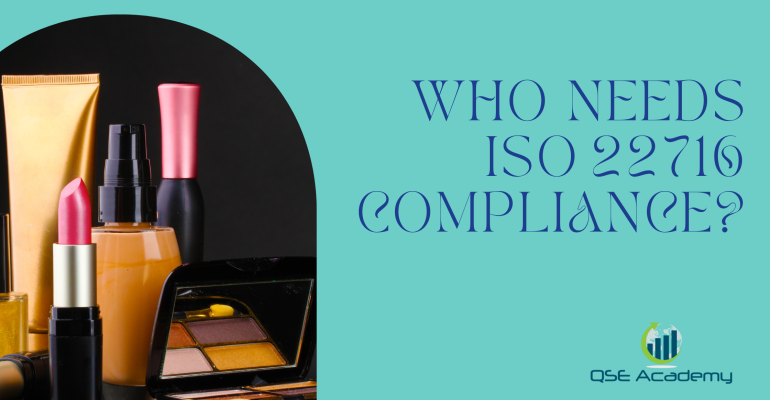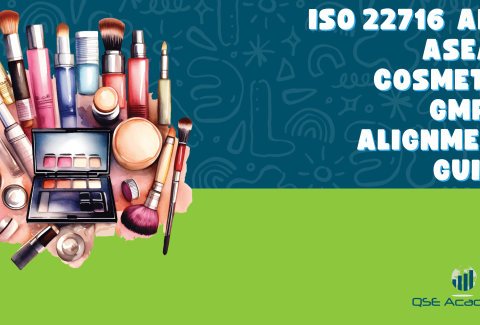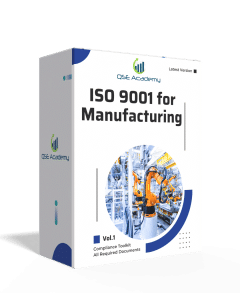Who Needs ISO 22716 Compliance?
Last Updated on October 24, 2025 by Hafsa J.
Why ISO 22716 Matters More Than Ever
If you’re in the cosmetics industry, chances are you’ve already heard of ISO 22716. But here’s what I keep noticing — many companies still don’t know whether it actually applies to them. Some assume it’s only for big manufacturers. Others think it’s just a fancy certification you hang on a wall. The truth? ISO 22716 affects almost everyone in the cosmetic supply chain, whether you’re producing, importing, labeling, or selling.
I’ve helped brands of every size — from global skincare giants to artisan soap makers — get compliant with ISO 22716 and prepare for EU 1223/2009 inspections. The confusion usually starts with one simple question: “Do we really need this?”
This article breaks that down clearly. You’ll find out exactly who needs ISO 22716 compliance, what triggers the requirement, and how it ties into your legal responsibilities under EU 1223/2009. Whether you’re a small-batch producer or a private-label brand, you’ll know how this standard protects your business — and your customers.
The Foundation – What ISO 22716 Really Covers
Before we dive into who needs it, let’s clarify what ISO 22716 actually is. I often tell clients to think of it as the instruction manual for making safe, consistent cosmetic products. It’s not a law — it’s a Good Manufacturing Practice (GMP) guideline. But here’s the catch: under EU Regulation 1223/2009, manufacturers must follow GMP, and ISO 22716 is the officially recognized reference for doing that.
In simple terms, ISO 22716 tells you how to:
-
Organize your production and quality control activities
-
Maintain clean, controlled environments
-
Train your staff properly
-
Keep detailed records for every batch you produce
-
Handle complaints, recalls, and deviations effectively
It’s about proving that your products are made safely, under repeatable and traceable conditions — not just that they “look fine” on the shelf.
Pro tip: Treat ISO 22716 as your daily guidebook, not a certification trophy. The goal isn’t the paper certificate; it’s the system that keeps your operation running cleanly, consistently, and audit-ready.
Common pitfall: Many small producers assume GMP doesn’t apply to them because they’re not “big.” But the law doesn’t care about company size — if you sell cosmetics commercially, GMP principles apply.
I’ve seen startups win trust (and investors) simply because they built their production systems around ISO 22716 from day one. It’s easier to scale when your foundation is solid.
Manufacturers – The Primary Audience for ISO 22716
If you make cosmetic products — whether you run a large production facility or a small blending lab — ISO 22716 was written for you. Manufacturers are the ones most directly responsible for implementing Good Manufacturing Practices (GMP) because every process, ingredient, and piece of equipment in your facility affects product safety.
In practice, ISO 22716 helps you structure your operations around three goals: control, consistency, and traceability. It guides you in documenting every production step, managing contamination risks, and ensuring staff follow defined procedures. When an auditor or regulator visits, this documentation is your best defense — it shows your products are safe and your system is under control.
Here’s what I’ve noticed over the years: companies that implement ISO 22716 properly experience fewer product recalls, smoother audits, and fewer disputes with suppliers. It’s not just about compliance — it’s about peace of mind.
Pro tip: Even if your market doesn’t yet demand certification, go through the implementation. Certification can come later. Once your GMP foundation is solid, you’ll be ready for both ISO audits and regulatory inspections.
Common pitfall: Some manufacturers rush to “get certified” without truly understanding the standard. They pass an audit once, then struggle to maintain consistency because the team wasn’t trained on the “why” behind each procedure.
Example: I once worked with a mid-size skincare factory in France that treated ISO 22716 like a paperwork exercise at first. After revising their batch documentation and equipment maintenance routines, they reduced product recalls by 70% and improved client trust almost overnight.
Brand Owners & Private-Label Companies – Why You’re Not Exempt
This is where many brands get caught off guard. They assume that since they don’t physically manufacture the products, ISO 22716 doesn’t apply to them. I’ve seen this mistake dozens of times — especially with private-label and white-label businesses.
Here’s the reality: under EU 1223/2009, the Responsible Person (RP) is legally accountable for ensuring every cosmetic product is manufactured in line with Good Manufacturing Practice (GMP). That means if your brand name appears on the label, you’re responsible — even if another company makes the product.
So yes, your contract manufacturer must follow ISO 22716. But you must also prove you’ve verified it. Regulators won’t accept “our supplier handles that” as an answer.
Pro tip: Always request your manufacturer’s current ISO 22716 certificate, along with their latest audit report or GMP declaration. Review them once or twice a year — not just during onboarding. It’s your best evidence of due diligence.
Common pitfall: Brands often rely on a single supplier visit or outdated certificate. Auditors and authorities expect ongoing supplier oversight. If your supplier loses certification or changes processes without your knowledge, you’re still liable.
Example: A UK-based private-label skincare brand I advised nearly faced product withdrawal when regulators discovered their subcontractor’s ISO 22716 certification had expired six months earlier. A quick supplier re-audit and internal compliance check helped them avoid penalties — but it was a close call.
Takeaway: Even if you don’t touch the product physically, ISO 22716 compliance is still your responsibility. The law doesn’t care who made it — it cares who placed it on the market.
Importers & Distributors – The Overlooked Link in the Chain
Importers and distributors often underestimate how much responsibility they carry in the compliance process. I’ve seen many cases where a company thought, “We just sell or deliver the products, so GMP doesn’t concern us.” Unfortunately, regulators don’t see it that way.
If you’re an importer, you’re legally responsible for ensuring every cosmetic product entering the EU market was manufactured under Good Manufacturing Practice — and ISO 22716 is the benchmark proof of that. It’s not enough to say, “Our supplier told us they follow GMP.” You need evidence — a valid certificate, audit reports, or a signed GMP declaration.
If you’re a distributor, your focus shifts slightly. You must ensure that products remain compliant during storage, handling, and transport. Temperature, humidity, and contamination control all fall under your scope. A single shipment stored improperly can jeopardize compliance, even if it left the manufacturer in perfect condition.
Pro tip: Create a supplier verification file for every product you handle. Include the ISO 22716 certificate, Responsible Person’s details, and PIF availability confirmation. When authorities ask, you can demonstrate traceability within minutes.
Common pitfall: Many distributors rely on verbal assurances from manufacturers. That’s not defensible. Without documented proof, you could face fines, product seizures, or even a market ban.
Example: A German distributor I worked with faced an unexpected inspection from local authorities. Because they had a complete file — including ISO 22716 certificates from all suppliers — the inspection ended in under two hours, with zero findings. Their preparation turned what could’ve been a stressful audit into a quick checkmark.
Takeaway: Whether you import or distribute, you’re part of the compliance chain. ISO 22716 might not change how you sell, but it absolutely shapes how you document and defend your compliance.
Small-Batch & Artisan Producers – GMP Still Applies
This group often gets overlooked, yet it’s where I see the most confusion. If you make small batches of soaps, creams, or serums at home or in a micro-lab and sell them commercially, you’re still expected to follow Good Manufacturing Practices. ISO 22716 isn’t just for industrial facilities with sterile rooms and full-time QA teams — it scales down remarkably well.
You don’t need fancy equipment or an external auditor to start. What matters is control and traceability.
Keep production areas clean, label every batch, store ingredients properly, and document what you do. Even handwritten records can demonstrate GMP awareness if they’re organized and consistent.
Pro tip: Start with a simplified ISO 22716 checklist that fits your setup. Document cleaning routines, ingredient sourcing, and how you handle defective products. You’ll be amazed how much credibility that adds when retailers or inspectors ask about compliance.
Common pitfall: Relying only on supplier quality or ingredient safety data. GMP covers your environment and handling — not just what comes in the door.
Example: I worked with a small artisanal soap brand in Portugal that sold mainly online. They didn’t need certification, but after implementing basic ISO 22716 controls (simple batch sheets, labeled storage, regular cleaning logs), they passed an EU market check with zero findings. The inspector even praised their clarity.
Takeaway: Small doesn’t mean exempt. If you sell to the public, ISO 22716 still applies — you just apply it at your scale.
Global Brands – Beyond the EU
If you think ISO 22716 only matters inside Europe, think again. Over the past few years, I’ve seen it evolve into a global passport for cosmetic trade. Countries in Asia, the Middle East, and Latin America increasingly reference ISO 22716 as their preferred GMP framework — sometimes even making it a prerequisite for import approval.
Markets like ASEAN, Saudi Arabia, the UAE, and Brazil recognize ISO 22716 as proof that your production system meets international hygiene, safety, and traceability standards. For global cosmetic brands, this makes ISO 22716 more than a compliance tool — it’s a strategic advantage.
Pro tip: Treat ISO 22716 as your universal compliance language. When your processes align with it, you don’t have to rebuild documentation every time you enter a new market. You can simply map your existing GMP controls to local regulations.
Common pitfall: Relying solely on EU compliance when expanding internationally. Some regions require additional documentation or local registration that still references ISO 22716 as part of GMP validation. Always verify early — it saves you from shipment delays or rejected filings.
Example: A Korean cosmetics exporter I worked with adopted ISO 22716 as its baseline system. That single move helped them meet both EU 1223/2009 and GSO (Gulf Standardization Organization) requirements without redesigning their quality management process. It cut their product registration time by nearly half.
Takeaway: Whether you’re expanding from Seoul to Stockholm or Dubai to Düsseldorf, ISO 22716 speaks the same language regulators understand — quality and consistency.
FAQs – Clearing Up Common Misunderstandings
1. Is ISO 22716 certification required by law?
No, it isn’t legally mandatory — but it’s the easiest way to show you comply with Good Manufacturing Practice (GMP) under EU Regulation 1223/2009. The regulation requires GMP; ISO 22716 just happens to be the globally recognized framework for it. So while you don’t need a certificate, you do need documented proof that your production follows the same principles.
2. Does ISO 22716 apply to distributors and importers too?
Yes, absolutely. You might not be the one mixing ingredients, but you’re still responsible for ensuring the products you sell were made under GMP conditions. Importers must verify their suppliers’ ISO 22716 compliance, and distributors must store and transport products safely to maintain that standard. Think of it as “shared responsibility” across the entire supply chain.
3. Can small or home-based businesses comply without full certification?
Definitely. Many small brands implement ISO 22716 principles without going through certification. The goal isn’t the paper—it’s the practice. Keep records, maintain clean production areas, label batches, and train your staff (even if it’s just you). Inspectors care far more about how consistently you apply GMP principles than whether you paid for an audit.
Know Your Role, Protect Your Brand
Here’s the bottom line: if your name, hands, or logistics touch a cosmetic product in any way — ISO 22716 applies to you. It doesn’t matter whether you’re a global manufacturer, a private-label brand, a local distributor, or an artisan formulator; Good Manufacturing Practices are the backbone of cosmetic safety and market credibility.
In my experience, the companies that thrive long-term are the ones that treat ISO 22716 as more than a checklist. They see it as a framework for quality, consistency, and trust. Once those habits take root, compliance stops feeling like a burden and starts functioning as a competitive edge.
Pro tip: Build your system once, and make it scalable. The same GMP principles that keep your small lab organized today will help you pass regulatory inspections when you grow tomorrow.
At QSE Academy, we’ve helped countless cosmetic businesses—from boutique brands to multinational producers—integrate ISO 22716 seamlessly into their everyday operations. If you’re ready to find out where you stand, download our “ISO 22716 Applicability Checklist” and identify exactly what steps apply to your business.
Compliance isn’t just about passing audits. It’s about protecting your brand, your customers, and your future.
Whether it’s ISO 9001, ISO 22000, or the cosmetics-focused ISO 22716, I’ve spent my career I’m not here to call myself an expert—I prefer “enthusiast” because I truly love what I do. When I’m not writing about standards, you’ll probably find me playing Piano 🎹, connecting with people, or diving into my next big project💫. I’m an engineer specialized in the food and agricultural industry
make ISO standards less intimidating and more approachable for everyone.
turning complex jargon into clear, actionable steps that businesses can actually use.
There’s something incredibly rewarding about helping people navigate food safety and quality management systems
in a way that feels simple, practical, and even enjoyable.
I have a Master’s in QHSE management and over 12 years of experience as a Quality Manager
I’ve helped more than 15 companies implement ISO 9001, ISO 22000, ISO 22716, GMP, and other standards
My clients include food producers, cosmetics manufacturers, laboratories, and service companies
I believe quality systems should be simple, useful, and efficient.











